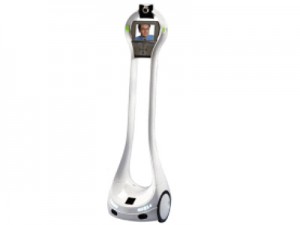Battlestar Galactica, the Terminator, Star Trek: TNG, and works by Ray Bradbury, Philip K. Dick, and Isaac Asimov, among many others, feature humanoid robots that are indistinguishable from humans. Such robots are discussed in more detail here. This post explores a different take on the hybridization of humans and robots–a sci-fi variation on the Minotaur.
On Futurama, Bender pawns his titanium body for mad cash, and by the time he figures out that being a body-less head has a few drawbacks, the pawn shop has sold his body to Richard Nixon–or more accurately, to Nixon’s disembodied, but perfectly preserved, head. Once joined with a titanium body, Nixon annihilates (literally) the competition and wins the presidency. This scenario may seem even less plausible than cylons or replicants, but is now making the first jump to reality with “robotic telepresence” technology.
The VGo looks a bit like a segway, if Apple were to design it. At the top is a computer screen, through which a user can see, hear, speak, and interact with people miles, states, or countries away.
VGo allows people who, because of physical disabilities or other limitations, can’t get to places they need to be, such as school. Students such as Zach Thomason, who has myotubular myopathy, a condition which results in extreme muscle weakness and immobility, can now “attend” school via VGo. While he can’t walk or manipulate objects such as pencils or pens on his own, Zach can use a joystick to control the VGo, positioning it so he can see the teacher and join discussions with his classmates.
A teenager in Colorado whose severe allergies prohibit her from attending school also uses the VGo. It took her a few days to get the hang of navigating the device—luckily it doesn’t complain when it smashes into walls, though it is sometimes stymied by closed doors. Although a teacher at the school charges the unit each evening, the student has had to send a few “help me!” emails when the unit has run out of battery power (the battery lasts approximately six hours).
The VGo app is available for PCs and Macs, and the user simply has to start the app on the computer in order to begin navigating. A connection to the internet is established via Wi-Fi or Verizon 4G LTE, and VGo remains connected to its own cloud-computing network, which finds the best possible connection in order to provide high quality audio, video, and navigation data.
“Driving” the VGo only requires moving a mouse or using the arrows on a keyboard. The unit is sensitive to both direction and speed. Positioning the camera at the top of the VGo unit is as easy as scrolling the mouse wheel.
The VGo can also be used by patients recovering from surgery or dealing with an illness, elderly people with limited or no mobility, or people who simply want or need to be somewhere they can’t go, such as a meeting in another city, or for doctors, the bedside of a patient at a different hospital.
I’m not sure how much Bender sold his body for, but VGos rival the price of titanium. The units are $6,000, and also require an annual service contract that runs about $100 a month. Users connecting via Verizon’s 4G network pay for that subscription as well.
VGo doesn’t have the monopoly on robotic telepresence–Xaxxon Technologies, iRobot, and Anybot offer similar functionality and services. At just under 10K (or $3,000 for an eight-hour rental), the Anybot makes the VGo look like a bargain; perhaps the extra $4,000 pays for the Anybot’s far more adorable “face.” While VGo publicizes itself largely through stories of students unable to physically attend school, Anybot makes the news for allowing the old and infirm to party like it’s 2099.
An 82-year-old mother who was unable to attend her son’s wedding in Paris sent an Anybot to France so she could attend by proxy. She had a photograph of herself in her wedding outfit enlarged and mounted on cardboard, and then she got onto the Anybot website and “drove” the bot around, including busting a move on the dance floor.
I look forward to the day I can invite a robot to a party instead of the actual person. I can think of quite a few people whose charms would be greatly accentuated by a robot emissary. And just imagine those party photos.





2 Responses to A Head of Its Time